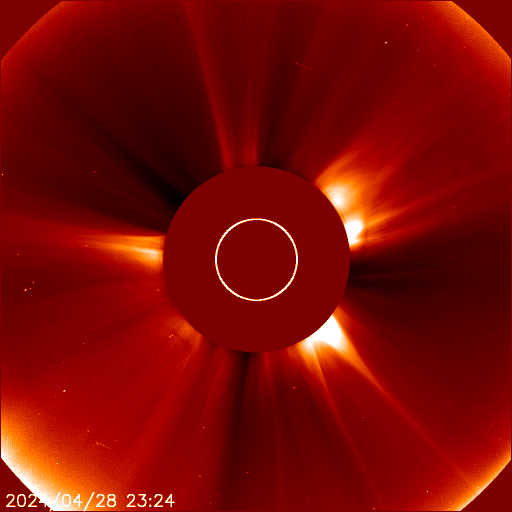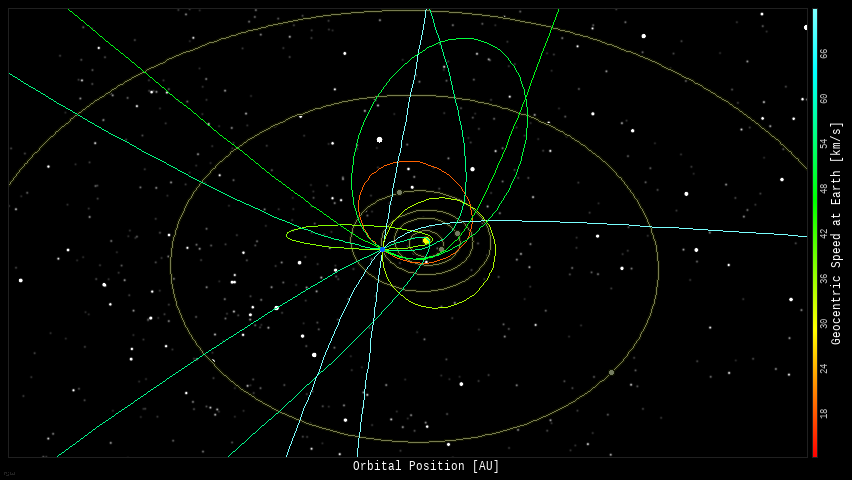There’s a helicopter on Mars!
The Ingenuity rovercraft has unfolded from the bottom of the Perseverance rover, and been dropped onto the surface of Mars. The craft survived its first frigid night on Mars; there is to be more testing of the power system and rotor blades before its first flight – scheduled for no sooner than April 11th.
NASA is definitely not taking Ironman’s “fly first, analyze later” approach to testing complicated mechanical systems – which, as an engineer, makes perfect sense… as a impatient space geek, it’s completely maddening!

Mars appears near the constellations Orion and Taurus high in the western sky after sunset all week.

Jupiter and Saturn appear low above the southeastern horizon before dawn all week; the Moon appears near Saturn on April 6th, and Jupiter on April 7th. The Moon appears in line with Jupiter and Saturn on April 8th.

The Moon is a waning crescent – visible low to the east before sunrise.
The new Moon occurs on April 12th – it will not be visible between April 10-13th.

If you click on the Moon image above, or click this link, you will go to NASA’s Moon Phase and Libration, 2021 page – it will show you what the Moon looks like right now. If you click the image on that page, you will download a high-rez TIFF image annotated with the names of prominent features – helpful for logging your lunar observations!
Moon News:

The Sun has 1 named sunspot – it’s small, and will soon be rotating out of view
SpaceWeather.com reports:
GEOMAGNETIC FORECAST: Today Earth’s polar magnetic field could be disturbed by the arrival of a minor solar wind stream. ETA: April 6th or 7th. The gaseous material is flowing from a southern hole in the sun’s atmosphere. Sky watchers around the Arctic Circle should be alert for auroras mixed with waxing Spring twilight.
Light coronal loop activity; several small coronal holes pepper the Sun’s facenear the equator seem to want to merge, but never actually do – that whole region just looks like it’s boiling! The hole at the Sun’s south pole is smaller than last week, and is about the same size as the northern hole.
Continuous prominence activity for the last couple days – the one in the upper right is very active!
You can view the Sun in near real-time, in multiple frequencies here: SDO-The Sun Now.
You can create your own time-lapse movies of the Sun here: AIA/HMI Browse Data.
You can browse all the SDO images of the Sun from 2010 to the present here: Browse SDO archive.
Solar Activity on Facebook – Run by Volunteer NASA/JPL Solar System Ambassador Pamela Shivak

Solar Corona
Solar wind speed is 321.1 km/sec, with a density of 11.4 protons/cm3 at 1030 UT.
Near real-time animation of the corona and solar wind from the Solar & Heliospheric Observatory (SOHO):

Sun News

- Near-Earth Objects (NEOs) discovered this month: : 49, this year: 757, all time: 25,567 (+52)
- Potentially hazardous asteroids: 2173 (+1, updated 2021-03-30)
- Total Minor Planets discovered (NASA): 1,071,546 (+2795)
- Total Minor Planets discovered (MPC): 1,043,047 (updated 2021-03-16)
Upcoming Earth-asteroid encounters:
| Asteroid | Date(UT) | Miss Distance | Velocity (km/s) | Diameter (m) |
| 2021 GP | 2021-Apr-06 | 4.4 LD | 4.5 | 7 |
| 2015 MB54 | 2021-Apr-06 | 13.6 LD | 3.7 | 57 |
| 2021 GL1 | 2021-Apr-06 | 5.1 LD | 12.4 | 25 |
| 2021 GB | 2021-Apr-06 | 7.9 LD | 4 | 14 |
| 2020 GE1 | 2021-Apr-07 | 12.2 LD | 4.2 | 14 |
| 2021 GG1 | 2021-Apr-07 | 5.3 LD | 14.4 | 18 |
| 2014 FO38 | 2021-Apr-07 | 16.8 LD | 8.3 | 20 |
| 2021 EH4 | 2021-Apr-08 | 13.1 LD | 7.7 | 36 |
| 2021 GT | 2021-Apr-09 | 2.9 LD | 12.2 | 19 |
| 2021 GT1 | 2021-Apr-10 | 12 LD | 5.5 | 24 |
| 2021 GZ | 2021-Apr-12 | 12.9 LD | 13.1 | 36 |
| 2021 GQ | 2021-Apr-12 | 8 LD | 5.9 | 23 |
| 2020 UY1 | 2021-Apr-15 | 16 LD | 8.7 | 22 |
| 2017 HG4 | 2021-Apr-16 | 7.6 LD | 4.1 | 10 |
| 2020 HE5 | 2021-Apr-17 | 8.5 LD | 4.3 | 10 |
| 2019 HQ | 2021-Apr-20 | 14.8 LD | 8.8 | 20 |
| 2020 HO5 | 2021-Apr-22 | 16.5 LD | 3.3 | 7 |
| 2019 PS1 | 2021-Apr-23 | 14.5 LD | 10 | 16 |
| 2016 QE45 | 2021-Apr-24 | 13.2 LD | 15.3 | 162 |
| 2021 FK3 | 2021-Apr-24 | 15.7 LD | 14 | 121 |
| 2015 HA177 | 2021-Apr-26 | 18.7 LD | 8.7 | 10 |
| 2019 HF4 | 2021-Apr-26 | 7.8 LD | 6.8 | 11 |
| 2021 EZ4 | 2021-Apr-29 | 14.9 LD | 2.5 | 20 |
| 2019 VT3 | 2021-May-01 | 12.1 LD | 5.9 | 8 |
| 2021 AF8 | 2021-May-04 | 8.8 LD | 9.4 | 344 |
| 2018 JP | 2021-May-05 | 10.6 LD | 7.8 | 12 |
| 2021 AE4 | 2021-May-06 | 18.5 LD | 9.1 | 153 |
| 2021 GK1 | 2021-May-12 | 1.5 LD | 2 | 13 |
| 2015 KJ19 | 2021-May-14 | 15.1 LD | 23 | 118 |
| 478784 | 2021-May-18 | 15.8 LD | 5 | 27 |
| 2013 VO11 | 2021-May-25 | 3.8 LD | 10.1 | 8 |
| 2018 LB | 2021-Jun-01 | 2.9 LD | 7.7 | 22 |
Asteroid News:

On April 5, 2021, the NASA All Sky Fireball Network reported 9 fireballs!
(9 sporadics)

Fireball News
If you see a bright meteor or a fireball, please REPORT IT to the American Meteor Society and the International Meteor Organization!

Position of the planets and several spacecraft in the inner solar system:

Position of the planets in the middle solar system:

Position of the planets, and a several transneptunian objects in the outer solar system.


International Space Station:
HiRISE – on the Mars Reconnaissance Orbiter:
Hubble Space Telescope:
Chandra X-Ray Observatory:
Climate:
See a list of current NASA missions here: https://www.jpl.nasa.gov/missions/?type=current

ex·o·plan·et /ˈeksōˌplanət/, noun: a planet orbiting a star other than the Sun.
Data from the NASA Exoplanet Archive
* Confirmed Planets Discovered by TESS refers to the number planets that have been published in the refereed astronomical literature.
* TESS Project Candidates refers to the total number of transit-like events that appear to be astrophysical in origin, including false positives as identified by the TESS Project.
* TESS Project Candidates Yet To Be Confirmed refers to the number of TESS Project Candidates that have not yet been dispositioned as a Confirmed Planet or False Positive.
Exoplanet News


SpaceWeather.com Realtime Aurora Gallery: https://spaceweathergallery.com/aurora_gallery.html

International Dark Sky Week (April 5-12)
Visit an International Dark Sky Park: https://www.darksky.org/our-work/conservation/idsp/parks/

For Teachers:
Hubble – Beautiful Universe: NGC 3628

What do spiral galaxies look like sideways? Featured is a sharp telescopic view of a magnificent edge-on spiral galaxy NGC 3628, a puffy galactic disk divided by dark dust lanes. Of course, this deep galactic portrait puts some astronomers in mind of its popular moniker, The Hamburger Galaxy.
The tantalizing island universe is about 100,000 light-years across and 35 million light-years away in the northern springtime constellation Leo. NGC 3628 shares its neighborhood in the local Universe with two other large spirals M65 and M66 in a grouping otherwise known as the Leo Triplet. Gravitational interactions with its cosmic neighbors are likely responsible for the extended flare and warp of this spiral’s disk.
– NASA/ESA
Stay safe, be well, and look up!
Software Apps used for this post:
NASA Eyes on the Solar System: an immersive 3D solar system and space mission simulator – free for the PC /MAC. I maintain the unofficial NASA Eyes Facebook page.
SpaceEngine: a free 3D Universe Simulator for Windows. Steam version with VR support available.
Stellarium: a free open source planetarium app for PC/MAC/Linux. It’s a great tool for planning observing sessions. A web-based version of Stellarium is also available.
Stellarium v0.21.0 was released on March 28th – there are numerous updates and features; the developers mentioned that they have published a scientific paper about the application of Stellarium in cultural astronomy: https://doi.org/10.1558/jsa.17822
Section header image credits:
The Sky – Stellarium / Bob Trembley
Observing Target – Turn Left at Orion / M. Skirvin
The Moon – NASA/JPL-Caltech
The Sun – NASA/JPL-Caltech
Asteroids – NASA/JPL-Caltech
Fireballs – Credited to YouTube
Comets – Comet P/Halley, March 8, 1986, W. Liller
The Solar System – NASA Eyes on the Solar System / Bob Trembley
Spacecraft News – NASA Eyes on the Solar System / Bob Trembley
Exoplanets – Space Engine / Bob Trembley
Light Pollution – NASA’s Black Marble
Aurora – Bob Trembley
The Universe – Universe Today





